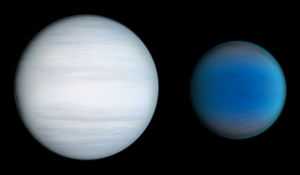Kepler-47c
| Extrasolar planet | List of extrasolar planets | |
|---|---|---|
 | ||
| Parent star | ||
| Star | Kepler-47 AB (KOI-3154) | |
| Right ascension | (α) | 19h 41m 11.5s |
| Declination | (δ) | +46° 55′ 12″ |
| Temperature | (T) | 5636(A) unknown (B) K |
| Physical characteristics | ||
| Radius | (r) | 4.61 ± 0.20 Re[1] R⊕ |
| Orbital elements | ||
| Semimajor axis | (a) | 0.989 ± 0.016 AU[1] AU |
| Eccentricity | (e) | < 0.411[1] |
| Orbital period | (P) | 303.158 ± 0.072 days[1] d |
| Inclination | (i) | 89.826 ± 0.010° [1]° |
| Discovery information | ||
| Discovery date | August 3, 2012[2] | |
| Discoverer(s) | ||
| Discovery method | Transit (Kepler Mission) | |
| Other detection methods | Transit timing variations, Transit duration variations | |
| Discovery status | Confirmed | |
| Other designations | ||
| KOI-3154 c
| ||
Kepler-47c is an extrasolar planet orbiting the circumbinary system Kepler-47 in the constellation Cygnus. The system, also involving another exoplanet, Kepler-47b, is about 4,900 light years away.[3] The binary system is the first to be found with more than one circumbinary planet.
Discovery
Kepler-47c, as well as Kepler-47b, was first discovered by scientists, from both NASA and the Tel-Aviv University in Israel, using the Kepler space telescope.[3][4] Additionally, the planetary characteristics of both planets were identified by a team of astronomers at the University of Texas at Austin's McDonald observatory.[3][5] Both planets were discovered after transiting their parent stars, and they both seem to be orbiting along the same plane.[4]
The two parent stars, Kepler-47A and Kepler-47B, orbit each other about every 7.45 days.[1] Kepler-47A is the larger and brighter of the two, being about the same size as the Sun and with about 84% of the sun's luminosity.[1] Kepler-47B, however, is only a little over 36% as large as the sun, and has only a little more than 1% of the sun's luminosity.[1]
Properties
Kepler-47c makes a complete orbit around its parent stars about every 303 days, and it lies within the system's habitable zone.[6] However, studies show it is most likely a gas giant planet, thus not being able to sustain life.[7] Hypothetically, though, any moons it may harbor could, with the right properties, support life.[6][7] Kepler-47c is slightly larger than the planet Neptune,[3] being about 4.6 times as large as Earth,[5] and could have a dense atmosphere of water vapor.[3]
Significance
Before the discovery of Kepler-47c, it was thought that binary stars with multiple planets could not exist. Gravitational issues caused by the parent stars would, it was believed, cause any circumbinary planets to either collide with each other, collide with one of the parent stars, or be flung out of orbit.[6] However, this discovery shows that multiple planets can form around binary stars, even in their habitable zones;[6] and while Kepler-47c is most likely unable to harbor life, other planets that could support life may orbit binary systems such as Kepler-47.[7]
See also
- List of extrasolar planet firsts
- List of planets discovered by the Kepler spacecraft
References
- ↑ 1.0 1.1 1.2 1.3 1.4 1.5 1.6 1.7 "Kepler-47bc". kepler.nasa.gov. Retrieved January 5, 2013.
- ↑ "Kepler-47: A Transiting Circumbinary Multiplanet System". sciencemag.org. August 28, 2012. Retrieved January 5, 2013.
- ↑ 3.0 3.1 3.2 3.3 3.4 "Two planets ... Two stars: Nasa detects strange new solar system (and one of the planets occupies the life-supporting 'Goldilocks zone')". dailymail.co.uk. August 30, 2012. Retrieved January 5, 2013.
- ↑ 4.0 4.1 "New worlds discovered, courtesy of US-Israel team". timesorisrael.com. August 30, 2012. Retrieved January 5, 2013.
- ↑ 5.0 5.1 "Astronomers Find First Multi-Planet System Around a Binary Star". spacedaily.com. September 3, 2012. Retrieved January 5, 2013.
- ↑ 6.0 6.1 6.2 6.3 "Tatooine-like double-star systems can host planets". bbc.co.uk. August 29, 2012. Retrieved January 5, 2013.
- ↑ 7.0 7.1 7.2 "Newfound 'Tatooine' Alien Planet Bodes Well for E.T. Search". space.com. September 4, 2012. Retrieved January 5, 2013.